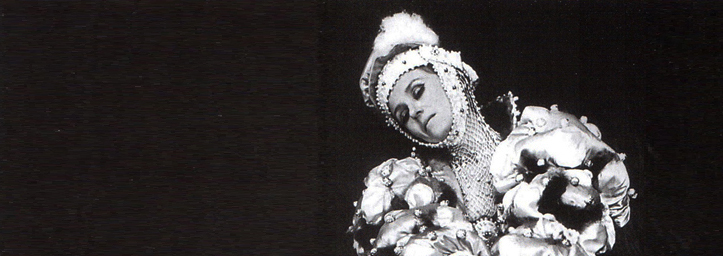Povilas Gaidys most clearly revealed his directorial talent and unique theatrical thinking through his comedies. He used these to draw attention to himself, demonstrating an early talent for an intelligent and multifaceted grasp of humor and its various manifestations on stage. The search for new opportunities for humor and for more complex and layered methods of comedic expression in the late 1960s brought Gaidys into the camp criticizing Soviet reality. Somehow he quite naturally resolved to take on the challenges of the grotesque aesthetic, choosing scenes from Soviet reality as a thematic foundation.
Gaidys hurled his illegal anti-Soviet offensives with the greatest effect by shackling "legal" Soviet comedies under the lock and key of the grotesque, in the productions of Ivan Kocherga's The Craftsmen of Time (1967), Vladimir Mayakoski's The Bathhouse (1970), Alexander Kopkov's Elephant (1977), and Viktor Merezhko's The Proletarian Mill of Happiness (1981). These different productions essentially were variations of the same theme: a brave proclamation of the general disorder of the Soviet system. Employing a particularly broad palette of comedic colors – parody, irony, caricature, clowning, grotesque – Gaidys used his productions to sketch out the contours of the illogical, lopsided and absurd Soviet world. He also addressed its inhumanity, about how brutally the Soviet system mangled its people, turning them into tools of "dystrophic bureaucratic thinking" (The Bathhouse) Rimantas Venckus, „Klaipėdos dramos teatras“, in: Lietuvių tarybinis dramos teatras: 1957–1970, sudarė Algirdas Gaižutis Vilnius: Vaga, 1987, p. 188. or "exhausted", "depersonified cogs in the collective 'order'" (Elephant). Gražina Mareckaitė, „Klaipėdos dramos teatras“, in: Lietuvių teatro istorija. Kn. 3: 1970–1980, sudarė Irena Aleksaitė, Vilnius: Kultūros, filosofijos ir meno institutas, 2006, p. 229.
These productions testified to Gaidys' maturity as a director: his precise and sharp sense of form on stage, his grasp of the grotesque, the persuasiveness of rhythm on stage, as well as the director's creative relationship with his acting company which, by the 1970s, was increasingly filled with talented, capable, and compelling artistic individuals such as Vytautas Paukštė, Balys Barauskas, Valentina Leonavičiūtė, Liubomiras Laucevičius, Henrikas Andriukonis, and others. The courageous anti-Soviet subtext of Gaidys' productions did, however, "damage" the director's political reputation and caused great confusion in Communist Party circles. Following the staging of The Bathhouse, intense "ideological court hearings" were held at Party meetings. Even Mayakovsky's prestige failed to protect against ominous accusations that Gaidys had forgotten the theatre's role as "bearer of communist ideals", requiring redemption for such a "poor memory" in the form of a tribute to the communist underground by staging Grigory Kanovich's The Long Life of the Dead in 1971. And yet, The Bathhouse survived the pressure, and remained part of the theatre's repertoire.
Today, the many episodes in the saga of Elephant's battles with censors can be appreciated like a good joke. Take, for example, the theatre's response to an order issued by the Lithuanian Soviet Socialist Republic's (LSSR) Ministry of Culture to get rid of the multicolored patches that had adorned the costumes of actors portraying collective farmers in the play's crowd scenes. The theatre dutifully obeyed the order: when the crowd appeared on stage, the patches had been replaced by gaping holes, evidence of "collective farm poverty" inspired by the censors themselves that, far from impoverishing the production, only served to lend more significance to Gaidys' directorial concept.




Comments
Write a comment